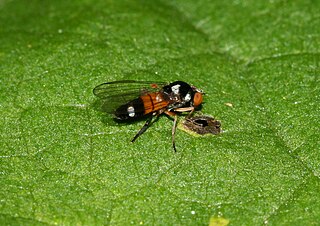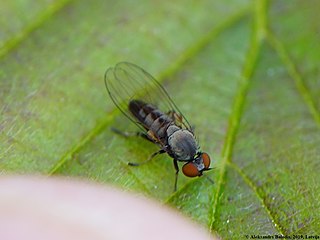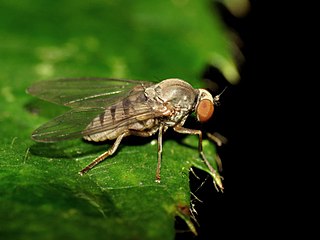
Xylomyidae is a family of flies known commonly as the wood soldier flies. They are xylophagous and are associated with dead or dying wood.

The Opetiidae is a family of true flies of the superfamily Platypezoidea, one of two families commonly called flat-footed flies. The family contains only five extant species in two genera, Opetia from the Palearctic region and Puyehuemyia from Chile in South America. Several fossil genera have been assigned to the family, but many of these are likely to belong elsewhere in the Platypezoidea. Lonchopterites from the Early Cretaceous Lebanese amber and Electrosania from the Late Cretaceous New Jersey amber seem likely to be closely related to modern opetiids.

Hybotidae, the typical dance flies, are a family of true flies. They belong to the superfamily Empidoidea and were formerly included in the Empididae as a subfamily.

Apsilocephalidae is a family of flies in the superfamily Asiloidea. It was historically treated as a subfamily within Therevidae, but placed in a separate family in 1991, and subsequently recognized as more distantly related. The family contains three extant genera and at least five extinct genera described from the fossil record.

Atelestidae is a family of flies in the superfamily Empidoidea. The four genera were placed in a separate family in 1983; they were formerly either in Platypezidae or considered incertae sedis. While they are doubtless the most basal of the living Empidoidea, the monophyly of the family is not fully proven. The genus Nemedina seems to represent a most ancient lineage among the entire superfamily, while Meghyperus is probably not monophyletic in its present delimitation, and it is liable to be split up eventually, with some species being placed elsewhere. In 2010, the genus Alavesia, previously only known from Cretaceous fossils, was found alive in Namibia, subsequent species were also described from Brazil.
Ironomyiidae is a small family of flies in the order Diptera. Historically, they had been included in the family Platypezidae, and includes three extant species within the single extant genus Ironomyia endemic to Australia and a number of extinct fossil genera from North America and Asia extending back to the Early Cretaceous.

Callomyia is a genus of flies in the family Platypezidae. Some species can be found in Belgium.

Lindneromyia is a genus of flat-footed flies. There are at least 70 described species in Lindneromyia.

Polyporivora is a genus of flat-footed flies. There are about eight described species in Polyporivora.
Grossoseta is a genus of flat-footed flies. There are at least two described species in Grossoseta.

Zhangsolvidae is an extinct family of brachyceran flies known from the Cretaceous period. Members of the family possess a long proboscis, varying in length between 1.3 and 7 mm depending on the species, and were probably nectarivores. A specimen has been found with preserved Bennettitales pollen, suggesting that they acted as pollinators for extinct gymnosperms. They are considered to be members of the Stratiomyomorpha.
Rhagionemestriidae is an extinct family of brachyceran flies known from the Jurassic and Cretaceous periods. It was first named as a subfamily of the Nemestrinidae by Ussatchov (1968), and was raised to full family status by Nagatomi and Yang (1998). They are considered to be closely related to the family Acroceridae. Similar to Acroceridae, members of the family possess a large hemispherical head, with eyes covering nearly all of the area.
Seri is a genus of flat-footed flies in the family Platypezidae.
Melanderomyia is a genus of flat-footed flies. There is one described species, Melanderomyia kahli.
Microsania is a genus of flat-footed flies in the family Platypezidae.

Agathomyia antennata is a species of flat-footed fly in the family Platypezidae.

Protoclythia is a genus of flat-footed flies in the family Platypezidae.
Protoclythia californica is a species of flat-footed flies in the family Platypezidae.
Pamelamyia is a genus of flat-footed flies. There is one described species, Pamelamyia stuckenbergorum.

Paraplatypeza is a genus of flat-footed flies in the family Platypezidae.














